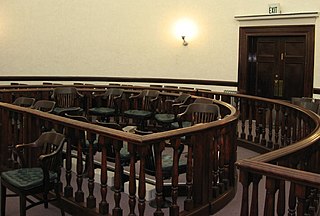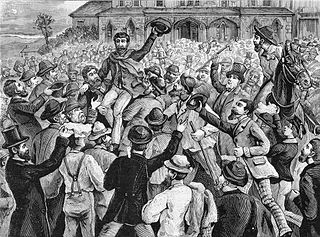
A jury trial, or trial by jury, is a legal proceeding in which a jury makes a decision or findings of fact. It is distinguished from a bench trial in which a judge or panel of judges makes all decisions.

A jury is a sworn body of people (jurors) convened to hear evidence and render an impartial verdict officially submitted to them by a court, or to set a penalty or judgment.
In a legal dispute, one party has the burden of proof to show that they are correct, while the other party has no such burden and is presumed to be correct. The burden of proof requires a party to produce evidence to establish the truth of facts needed to satisfy all the required legal elements of the dispute.
Judgment notwithstanding the verdict, also called judgmentnon obstante veredicto, or JNOV, is a type of judgment as a matter of law that is sometimes rendered at the conclusion of a jury trial.
Jury nullification (US/UK), jury equity (UK), or a perverse verdict (UK) occurs when the jury in a criminal trial gives a not guilty verdict regardless of whether they believe a defendant has broken the law. The jury's reasons may include the belief that the law itself is unjust, that the prosecutor has misapplied the law in the defendant's case, that the punishment for breaking the law is too harsh, or general frustrations with the criminal justice system. Some juries have also refused to convict due to their own prejudices in favor of the defendant. Such verdicts are possible because a jury has an absolute right to return any verdict it chooses.

In common law jurisdictions, an acquittal means that the prosecution has failed to prove that the accused is guilty beyond a reasonable doubt of the charge presented. It certifies that the accused is free from the charge of an offense, as far as criminal law is concerned. The finality of an acquittal is dependent on the jurisdiction. In some countries, such as the United States, an acquittal prohibits the retrial of the accused for the same offense, even if new evidence surfaces that further implicates the accused. The effect of an acquittal on criminal proceedings is the same whether it results from a jury verdict or results from the operation of some other rule that discharges the accused. In other countries, like Australia and the UK, the prosecuting authority may appeal an acquittal similar to how a defendant may appeal a conviction — but usually only if new and compelling evidence comes to light or the accused has interfered with or intimidated a juror or witness.
In law, a summary judgment, also referred to as judgment as a matter of law or summary disposition, is a judgment entered by a court for one party and against another party summarily, i.e., without a full trial. Summary judgments may be issued on the merits of an entire case, or on discrete issues in that case. The formulation of the summary judgment standard is stated in somewhat different ways by courts in different jurisdictions. In the United States, the presiding judge generally must find there is "no genuine dispute as to any material fact and the movant is entitled to judgment as a matter of law." In England and Wales, the court rules for a party without a full trial when "the claim, defence or issue has no real prospect of success and there is no other compelling reason why the case or issue should be disposed of at a trial."
In United States law, a motion is a procedural device to bring a limited, contested issue before a court for decision. It is a request to the judge to make a decision about the case. Motions may be made at any point in administrative, criminal or civil proceedings, although that right is regulated by court rules which vary from place to place. The party requesting the motion is the moving party or movant. The party opposing the motion is the nonmoving party or nonmovant.
A hung jury, also called a deadlocked jury, is a judicial jury that cannot agree upon a verdict after extended deliberation and is unable to reach the required unanimity or supermajority. Hung juries usually result in the case being tried again.
Not proven is a verdict available to a court of law in Scotland. Under Scots law, a criminal trial may end in one of three verdicts, one of conviction ("guilty") and two of acquittal.
Beyond (a) reasonable doubt is a legal standard of proof required to validate a criminal conviction in most adversarial legal systems. It is a higher standard of proof than the standard of balance of probabilities commonly used in civil cases because the stakes are much higher in a criminal case: a person found guilty can be deprived of liberty, or in extreme cases, life, as well as suffering the collateral consequences and social stigma attached to a conviction. The prosecution is tasked with providing evidence that establishes guilt beyond a reasonable doubt in order to get a conviction; albeit prosecution may fail to complete such task, the trier-of-fact's acceptance that guilt has been proven beyond a reasonable doubt will in theory lead to conviction of the defendant. A failure for the trier-of-fact to accept that the standard of proof of guilt beyond a reasonable doubt has been met thus entitles the accused to an acquittal. This standard of proof is widely accepted in many criminal justice systems, and its origin can be traced to Blackstone's ratio, "It is better that ten guilty persons escape than that one innocent suffer."

In law, a trial is a coming together of parties to a dispute, to present information in a tribunal, a formal setting with the authority to adjudicate claims or disputes. One form of tribunal is a court. The tribunal, which may occur before a judge, jury, or other designated trier of fact, aims to achieve a resolution to their dispute.
In France, a cour d'assises, or Court of Assizes or Assize Court, is a criminal trial court with original and appellate limited jurisdiction to hear cases involving defendants accused of felonies, meaning crimes as defined in French law. It is the only French court that uses a jury trial.

The court of assizes is the trial court which tries the most serious crimes in the judicial system of Belgium. It is the highest Belgian court with criminal jurisdiction; as such, it is the only Belgian court that can sentence someone to life imprisonment. The courts of assizes are not permanent courts; a new court of assizes is assembled for each new trial. There is a court of assizes in each of the ten provinces of Belgium, as well as one in the arrondissement of Brussels-Capital which is not part of any province. Further below, an overview is provided of the eleven courts of assizes and their seats. They are the only courts in Belgium for which the provinces are used as territorial subdivisions. They are also the only courts in Belgium that hold jury trials. The jury acts as sole trier of fact, but decides on the penalty together with the judges. The trial by jury of certain crimes is laid down in article 150 of the Belgian Constitution. The Belgian courts of assizes have the same origin as their French namesakes.
No case for the defendant to answer is a term in the criminal law of some Commonwealth states, whereby a defendant seeks acquittal without having to present a defence, because of the insufficiency of the prosecution's case. The motion is infrequently used in civil cases where the defendant asserts that the plaintiff's case is insufficient to prove liability.
United States criminal procedure derives from several sources of law: the baseline protections of the United States Constitution; federal and state statutes; federal and state rules of criminal procedure ; and state and federal case law. Criminal procedures are distinct from civil procedures in the US.
In the United States, jury nullification occurs when a jury in a criminal case reaches a verdict contrary to the weight of evidence, sometimes because of a disagreement with the relevant law. It has its origins in colonial America under British law. The American jury draws its power of nullification from its right to render a general verdict in criminal trials, the inability of criminal courts to direct a verdict no matter how strong the evidence, the Fifth Amendment's Double Jeopardy Clause, which prohibits the appeal of an acquittal, and the fact that jurors cannot be punished for the verdict they return.
The Virginia Circuit Courts are the state trial courts of general jurisdiction in the Commonwealth of Virginia. The Circuit Courts have jurisdiction to hear civil and criminal cases. For civil cases, the courts have authority to try cases with an amount in controversy of more than $4,500 and have exclusive original jurisdiction over claims for more than $25,000. In criminal matters, the Circuit Courts are the trial courts for all felony charges and for misdemeanors originally charged there. The Circuit Courts also have appellate jurisdiction for any case from the Virginia General District Courts claiming more than $50, which are tried de novo in the Circuit Courts.

The Italian Code of Criminal Procedure contains the rules governing criminal procedure in every court in Italy. The Italian legal order adopted four codes since the Italian Unification. After the first two codes, in 1865 and 1913, the Fascist Government established in 1930 a new code adopting an inquisitorial system. In 1988 the Italian Republic adopted a new code, that could be considered to be somewhere in between the inquisitorial system and the adversarial system.
A citizen's right to a trial by jury is a central feature of the United States Constitution. It is considered a fundamental principle of the American legal system.







